Are there trees in Iceland?
By Michael Chapman
Reforestation efforts are underway to restore Iceland's formerly lush woodlands.
Yes, visitors will find many tree species across the country, the most common being Birch, Poplar, Pine and Rowan. However, there is no denying that Iceland is deprived of vast wooded areas, with only a few locations—including Hallormsstaðaskógur in East Iceland, and Reykjavík's Öskjuhlíð Hill—that constitute actual forests.
While forests are an everyday sight across much of mainland Europe and North America, Iceland bucks the trend, trading in its trees for stark lava fields, glacial valleys and vast black sand deserts. Where there are trees, they tend to be young, relatively small and concentrated in preorganised patches. Such diminutive woodlands has led to the widely-shared Icelandic wisecrack;
‘What’s your best move if you get lost in an Icelandic forest?’
‘Just stand up!’
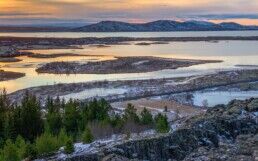
This absence of sprawling forests—or, indeed many trees at all—is one of the first things international visitors notice upon their arrival. Stepping out of Keflavík Airport, the gnarled, liquorice-black rocks of Reykjanes Peninsula are visible at once, stretching out to distant hilltops whose sparse slopes are forever exposed to the elements.
This scarcity of flora leaves us with a poignant question. Has Iceland always been short of trees, and if not, what happened to change the look, no less the make-up of this island so drastically?
Yes, visitors will find many tree species across the country, the most common being Birch, Poplar, Pine and Rowan. However, there is no denying that Iceland is deprived of vast wooded areas, with only a few locations—including Hallormsstaðaskógur in East Iceland, and Reykjavík’s Öskjuhlíð Hill—that constitute actual forests.
While forests are an everyday sight across much of mainland Europe and North America, Iceland bucks the trend, trading in its trees for stark lava fields, glacial valleys and vast black sand deserts. Where there are trees, they tend to be young, relatively small and concentrated in preorganised patches. Such diminutive woodlands has led to the widely-shared Icelandic wisecrack;
‘What’s your best move if you get lost in an Icelandic forest?’
‘Just stand up!’

This absence of sprawling forests—or, indeed many trees at all—is one of the first things international visitors notice upon their arrival. Stepping out of Keflavík Airport, the gnarled, liquorice-black rocks of Reykjanes Peninsula are visible at once, stretching out to distant hilltops whose sparse slopes are forever exposed to the elements.
This scarcity of flora leaves us with a poignant question. Has Iceland always been short of trees, and if not, what happened to change the look, no less the make-up of this island so drastically?
How did Iceland lose its forests?
The picturesque and instantly-recognisable desolation that characterises much of Iceland was not always so prominent. Whereas meadows and deserts, glacial expanses and steamy geothermal highlands are now considered iconic of Icelandic nature, the island has changed dramatically over the centuries.
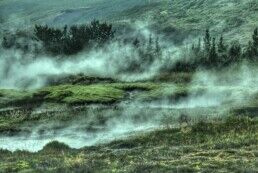
According to scientific records, between 20-40% of the country was dense with forest cover when humans first arrived around 870 AD. The ancient Landnámabók—a saga better known as the Book of Settlement—confirms this with its poetic description of land “covered with wood between the seashore and the mountains.”
In a bid to survive the hardships of their newfound home, the early settlers chopped down trees with alarming speed, using the timber for fuel, home and shipbuilding, while clearing the remainder of the space for agriculture—typical for all agrarian societies. Given that the landmass was only 15 million years old at the settlement point, it is widely agreed upon among scientists that the ecosystem was not primed to deal with such a sudden influx of resource-hungry organisms.
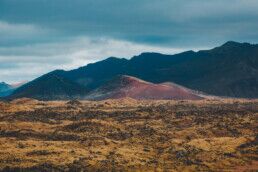
Charcoal was an essential product sourced from the forest, vital for the smelting of iron and manufacturing of tools. This reliance on charcoal was only alleviated in the mid-19th century when Icelandic farmers could import new equipment from overseas. The local people were still using wood as fuel to heat their homes as late as 1940, which is an incredible thought given the country’s self-reliance on geothermal energy today.
By then, of course, much of the landscape had already been pilfered of its resources. Eyeing our surroundings now, the most evident reminder of the settlers’ past action is the barren and windswept country they left behind.
Though so not visible, another lasting consequence is soil quality, which is decidedly poor here in Iceland. Soil erosion is the greatest obstacle faced by those looking to reforest the land and refers to how the top layer of any given soil is displaced over time by water, wind and ice.
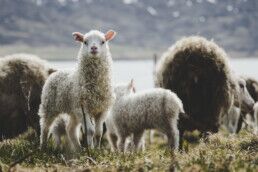
Farming is among the worst culprits of soil erosion. Given that sheep have been a staple of the Icelandic diet since around 1300 AD, local agriculture has had enormous influence over which flora prospers, and which dies out. Many foresters refer to Iceland as the ‘wet desert’ given the difficulties of planting now flora.
Humans and livestock are not solely to blame for Iceland’s deforestation, however. Sporadic volcanic disturbances and various periods of rapid cooling can also be pegged as reasons for why Iceland’s forests diminished in such a short period.
How did Iceland lose its forests?
The picturesque and instantly-recognisable desolation that characterises much of Iceland was not always so prominent. Whereas meadows and deserts, glacial expanses and steamy geothermal highlands are now considered iconic of Icelandic nature, the island has changed dramatically over the centuries.

According to scientific records, between 20-40% of the country was dense with forest cover when humans first arrived around 870 AD. The ancient Landnámabók—a saga better known as the Book of Settlement—confirms this with its poetic description of land “covered with wood between the seashore and the mountains.”
In a bid to survive the hardships of their newfound home, the early settlers chopped down trees with alarming speed, using the timber for fuel, home and shipbuilding, while clearing the remainder of the space for agriculture—typical for all agrarian societies. Given that the landmass was only 15 million years old at the settlement point, it is widely agreed upon among scientists that the ecosystem was not primed to deal with such a sudden influx of resource-hungry organisms.

Charcoal was an essential product sourced from the forest, vital for the smelting of iron and manufacturing of tools. This reliance on charcoal was only alleviated in the mid-19th century when Icelandic farmers could import new equipment from overseas. The local people were still using wood as fuel to heat their homes as late as 1940, which is an incredible thought given the country’s self-reliance on geothermal energy today.
By then, of course, much of the landscape had already been pilfered of its resources. Eyeing our surroundings now, the most evident reminder of the settlers’ past action is the barren and windswept country they left behind.
Though so not visible, another lasting consequence is soil quality, which is decidedly poor here in Iceland. Soil erosion is the greatest obstacle faced by those looking to reforest the land and refers to how the top layer of any given soil is displaced over time by water, wind and ice.

Farming is among the worst culprits of soil erosion. Given that sheep have been a staple of the Icelandic diet since around 1300 AD, local agriculture has had enormous influence over which flora prospers, and which dies out. Many foresters refer to Iceland as the ‘wet desert’ given the difficulties of planting now flora.
Humans and livestock are not solely to blame for Iceland’s deforestation, however. Sporadic volcanic disturbances and various periods of rapid cooling can also be pegged as reasons for why Iceland’s forests diminished in such a short period.
Is Iceland planting new trees?
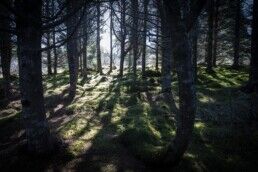
Reforestation efforts are underway to transform this island’s landscape into one of rich, luscious woodlands. Planting and restocking is a relatively new concept here; less than a century ago, most Icelanders would have believed it impossible that any tree could grow in Iceland, let alone entire patches of woodland.
A greater level of forest management experience and a deeper scientific understanding have helped shift this perspective among the local populace away from draining resources to preserving them. In our modern era, most Icelanders are all too aware of the benefits and rewards that future forests might provide, a realisation which has helped bolster the nation’s image as environmentally proactive.
Regardless of this positive change in attitude, Iceland’s climate is still openly hostile for much of the year, making for slow progress regarding reforestation. Bear in mind, before a single tree is planted, a base-level of vegetation must be first grown, which takes time and luck to be successful.
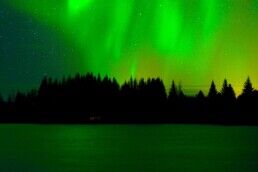
It is because of these odds that only around 0.5% of Iceland’s landmass is forested today. Still, the country has seen between 3 – 4 million trees planted since 2015, which only goes to show the motivation is there to surmount the challenges posed by the environment.
Other issues that must be overcome are Iceland’s reliance on grazing animals and the more significant threat posed by global warming, which tends to be behind the death of many young saplings, including those of the native birch.
The Icelandic government has aimed for 5% forest cover in fifty years, though given what we’ve learnt, many foresters consider this to be overly-ambitious. Regardless, among the new trees being planted are larch, Alaska aspen, Sitka spruce and logdgepoles. While young now, future generations looking upon these new additions to Iceland’s wildlife will, no doubt, be grateful for the efforts we made today.
Is Iceland planting new trees?

Reforestation efforts are underway to transform this island’s landscape into one of rich, luscious woodlands. Planting and restocking is a relatively new concept here; less than a century ago, most Icelanders would have believed it impossible that any tree could grow in Iceland, let alone entire patches of woodland.
A greater level of forest management experience and a deeper scientific understanding have helped shift this perspective among the local populace away from draining resources to preserving them. In our modern era, most Icelanders are all too aware of the benefits and rewards that future forests might provide, a realisation which has helped bolster the nation’s image as environmentally proactive.
Regardless of this positive change in attitude, Iceland’s climate is still openly hostile for much of the year, making for slow progress regarding reforestation. Bear in mind, before a single tree is planted, a base-level of vegetation must be first grown, which takes time and luck to be successful.

It is because of these odds that only around 0.5% of Iceland’s landmass is forested today. Still, the country has seen between 3 – 4 million trees planted since 2015, which only goes to show the motivation is there to surmount the challenges posed by the environment.
Other issues that must be overcome are Iceland’s reliance on grazing animals and the more significant threat posed by global warming, which tends to be behind the death of many young saplings, including those of the native birch.
The Icelandic government has aimed for 5% forest cover in fifty years, though given what we’ve learnt, many foresters consider this to be overly-ambitious. Regardless, among the new trees being planted are larch, Alaska aspen, Sitka spruce and logdgepoles. While young now, future generations looking upon these new additions to Iceland’s wildlife will, no doubt, be grateful for the efforts we made today.
Where do trees grow in Iceland?
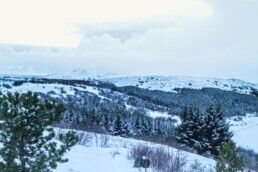
As previously mentioned, the most common trees seen in Iceland are Rowan, Poplar and Birch, as these tend to be prioritised in reforestation projects. Patches of these woods can be seen throughout the country. With that said, many other species contribute to this island’s biodiversity, if only you know where to look!
Hallormsstaðaskógur, in the east of the country, is Iceland’s largest national forest, made up primarily of native dwarf and mountain birch trees. We say primarily because around ninety species of foreign tree from over 177 locations worldwide can be seen while strolling one of the forest’s pleasant hiking trails. Thankfully, each species comes with an information board that lists more details on each plant and its origins.
Hallormsstaðaskógur is something of an amolay in Iceland. The site began with the planting of fifty saplings in 1905, making it the first and largest protected forest in Iceland. This status has had a litany of positive effects in the years since then. A plethora of wild berries now grow there, ready for the picking, and the forest homes a very diverse range of bird species, including the likes of Redpolls and Goldcrests.
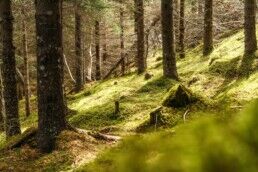
Today, this area on the banks of Lake Lagarfljot is spread over 740 scenic hectares, and as such, attracts thousands of campers, cyclists and picnickers every single year. Don’t miss out on paying a visit yourself should you travel around East Iceland in the future.
In sheltered areas and greenhouses, some intuitive locals have even taken to growing their own fruit trees; something that would have been considered all but impossible not that long ago. Apples and tomatoes are now considered something of a speciality, and bananas have been grown here since the 1940s. Such success shows a real determination in the Icelandic people to cultivate entirely new ecosystems and crops across their land.
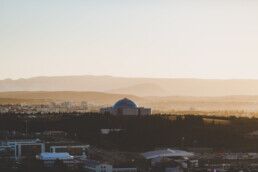
One location it is possible to appreciate just how much potential Iceland has for growing new species of plants is Lystigarður Akureyrar, better known as the Akureyri Botanical Gardens. Despite its proximity to the Arctic Circle, this quaint and colourful attraction boasts over 7000 different flora types, securing it as a fantastic family outing for summer visitors.
In Iceland’s official capital, Reykjavík, the best known forested area is Öskjuhlíð Hill, where the famed landmark, Perlan Museum and Observation Deck, is also found. Popular with city residents looking for a quick escape into nature, over 200,000 trees have been planted on the site since the project began in 1950. Visitors to this beloved hill should also check out the abandoned WW2 outposts, as well as the geothermal beach, Nauthólsvík.
If you’re looking for a comprehensive list as to where all of Iceland’s National Forests can be found, make sure to peruse this map by the Icelandic Forest Service.
Where do trees grow in Iceland?

As previously mentioned, the most common trees seen in Iceland are Rowan, Poplar and Birch, as these tend to be prioritised in reforestation projects. Patches of these woods can be seen throughout the country. With that said, many other species contribute to this island’s biodiversity, if only you know where to look!
Hallormsstaðaskógur, in the east of the country, is Iceland’s largest national forest, made up primarily of native dwarf and mountain birch trees. We say primarily because around ninety species of foreign tree from over 177 locations worldwide can be seen while strolling one of the forest’s pleasant hiking trails. Thankfully, each species comes with an information board that lists more details on each plant and its origins.
Hallormsstaðaskógur is something of an amolay in Iceland. The site began with the planting of fifty saplings in 1905, making it the first and largest protected forest in Iceland. This status has had a litany of positive effects in the years since then. A plethora of wild berries now grow there, ready for the picking, and the forest homes a very diverse range of bird species, including the likes of Redpolls and Goldcrests.

Today, this area on the banks of Lake Lagarfljot is spread over 740 scenic hectares, and as such, attracts thousands of campers, cyclists and picnickers every single year. Don’t miss out on paying a visit yourself should you travel around East Iceland in the future.
In sheltered areas and greenhouses, some intuitive locals have even taken to growing their own fruit trees; something that would have been considered all but impossible not that long ago. Apples and tomatoes are now considered something of a speciality, and bananas have been grown here since the 1940s. Such success shows a real determination in the Icelandic people to cultivate entirely new ecosystems and crops across their land.

One location it is possible to appreciate just how much potential Iceland has for growing new species of plants is Lystigarður Akureyrar, better known as the Akureyri Botanical Gardens. Despite its proximity to the Arctic Circle, this quaint and colourful attraction boasts over 7000 different flora types, securing it as a fantastic family outing for summer visitors.
In Iceland’s official capital, Reykjavík, the best known forested area is Öskjuhlíð Hill, where the famed landmark, Perlan Museum and Observation Deck, is also found. Popular with city residents looking for a quick escape into nature, over 200,000 trees have been planted on the site since the project began in 1950. Visitors to this beloved hill should also check out the abandoned WW2 outposts, as well as the geothermal beach, Nauthólsvík.
If you’re looking for a comprehensive list as to where all of Iceland’s National Forests can be found, make sure to peruse this map by the Icelandic Forest Service.
Experience Iceland's Forest in a Bubble
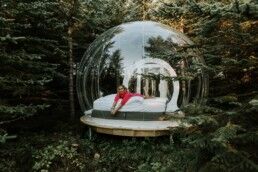
Without a doubt, one of the best means of experiencing an Icelandic forest is to spend a night or two in one of our fantastic bubbles. We offer two locations that maximise the beauty and ambience of Iceland’s forests, culminating in a tranquil overnight experience quite unlike anything you’ve experienced before.
Nestled amid the trees and vegetation, this novel, yet highly sought-after accommodation, allows guests to reconnect with the environment’s natural rhythms in comfort and style. With their transparent walls and ceilings, you will have a 360-degree panorama of the pine and shrubbery from inside your cosy bubble, not mentioning the wide-open skies above.
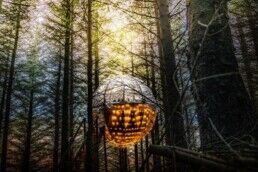
In summer, you’ll find these woodlands bathed in the apricot wash of the Midnight Sun, while the winter welcomes in virgin snowfall, intricate frost sculptures, and the promise of witnessing the elusive Aurora Borealis. Whatever season you choose to visit us, a stay at the Bubble hotel is sure to provide you with both lasting memories and a newfound appreciation of the world around you.
Perfect for stargazers, Northern Lights hunters and all-round nature-lovers, choosing one of our bubbles is choosing to spend the most luxurious night in the wilderness you’ll likely ever have. During the day, you have both the famous Golden Circle and South Coast sightseeing routes on your doorstep, allowing you to see Iceland’s most beloved natural attractions.
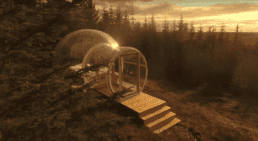
For those who want peak immersion, might we recommend our new hanging bubble. This stunning addition to our accommodation choices will sure to bring new heights to your experience in the forest. Make sure to check out our guided tours and overnight packages before you decide to discover Iceland’s small, yet beautiful forests for yourself.
Experience Iceland's Forest in a Bubble

Without a doubt, one of the best means of experiencing an Icelandic forest is to spend a night or two in one of our fantastic bubbles. We offer two locations that maximise the beauty and ambience of Iceland’s forests, culminating in a tranquil overnight experience quite unlike anything you’ve experienced before.
Nestled amid the trees and vegetation, this novel, yet highly sought-after accommodation, allows guests to reconnect with the environment’s natural rhythms in comfort and style. With their transparent walls and ceilings, you will have a 360-degree panorama of the pine and shrubbery from inside your cosy bubble, not mentioning the wide-open skies above.

In summer, you’ll find these woodlands bathed in the apricot wash of the Midnight Sun, while the winter welcomes in virgin snowfall, intricate frost sculptures, and the promise of witnessing the elusive Aurora Borealis. Whatever season you choose to visit us, a stay at the Bubble hotel is sure to provide you with both lasting memories and a newfound appreciation of the world around you.
Perfect for stargazers, Northern Lights hunters and all-round nature-lovers, choosing one of our bubbles is choosing to spend the most luxurious night in the wilderness you’ll likely ever have. During the day, you have both the famous Golden Circle and South Coast sightseeing routes on your doorstep, allowing you to see Iceland’s most beloved natural attractions.

For those who want peak immersion, might we recommend our new hanging bubble. This stunning addition to our accommodation choices will sure to bring new heights to your experience in the forest. Make sure to check out our guided tours and overnight packages before you decide to discover Iceland’s small, yet beautiful forests for yourself.